JSS University Mysore BBA Admissions 2025
NAAC A++ Accredited| Ranked #24 in University Category by NIRF
The CUET PG MBA 2026 exam is an important step for students preparing for postgraduate management studies. As the exam gets closer, focusing on quick and effective revision becomes very important. Going through last-minute questions helps revise key topics, refresh concepts, and improve exam confidence. These questions also help students understand the type of problems they may face in the exam. This Careers360 article is created to help CUET PG MBA 2026 aspirants with focused last-minute revision questions for better preparation.
This Story also Contains
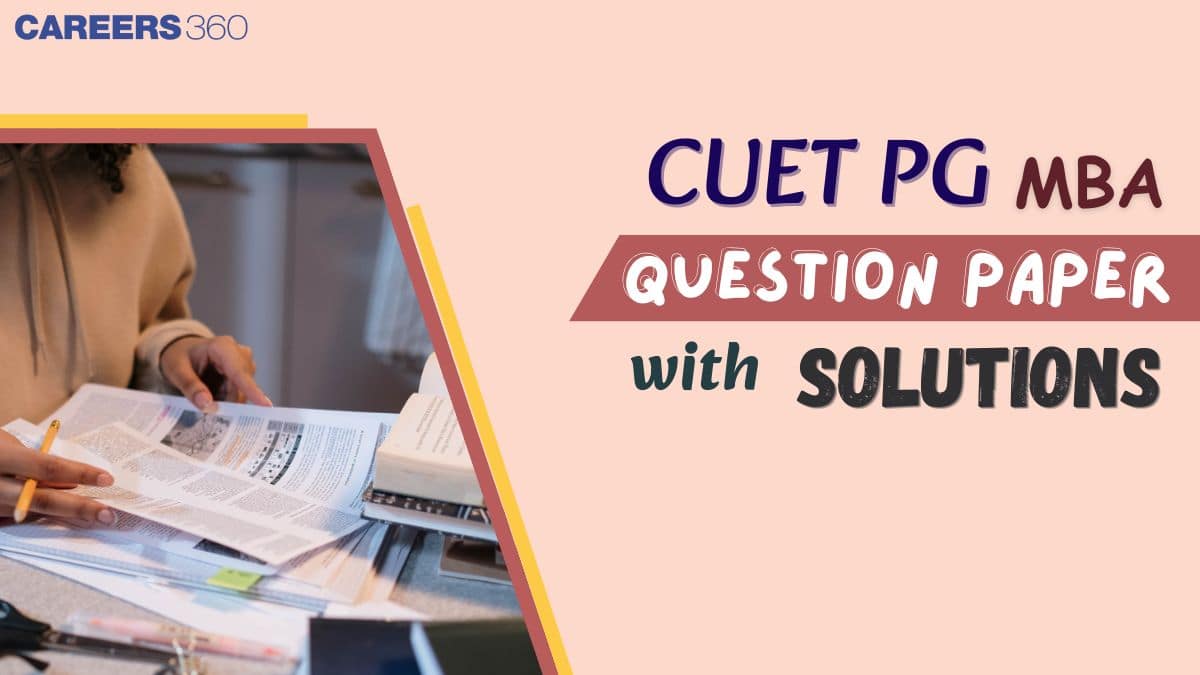
Understanding the complete CUET PG 2026 exam pattern is essential for candidates to score better in the CUET PG examination. The detailed CUT PG 2026 exam pattern is provided below for the reference of the candidates.
| Particulars | CUET PG exam Details |
|---|---|
CUET PG Conducting Authority | National Testing Agency (NTA) |
Types of questions | MCQs |
Exam mode | Computer-based mode |
Total number of questions | 75 |
CUET PG exam time duration | 90 Minutes |
Total marks in CUET PG | 300 marks |
CUET PG Marking Scheme | 4 marks will be given for each correct response. 1 mark will be deducted for each incorrect response. |
CUET PG negative marking | Yes |
CUET PG passing marks | 45% marks |
The CUET PG MBA 2026 expected topic-wise weightage is based on a detailed review of the CUET PG MBA 2025 question paper. This analysis helps students understand which topics appear more often and need greater attention during preparation.
Since the CUET PG exam pattern remains largely consistent each year, this topic-wise weightage helps aspirants plan their studies more effectively. It allows them to focus on important areas, manage time better, and improve accuracy for the CUET PG MBA 2026 exam.
| Topic | Number of Questions |
|---|---|
Grammar (Tenses, Articles, Prepositions, SVA) | 8 |
Vocabulary (Synonyms, Antonyms, Word Meaning) | 7 |
Idioms & Phrases | 4 |
Sentence Improvement / Error Spotting | 3 |
Para Jumbles / Paragraph Completion | 3 |
Total | 25 |
| Topics | Number of Questions |
|---|---|
Percentages | 5 |
Profit & Loss | 4 |
Simple & Compound Interest | 4 |
Ratio & Partnership | 4 |
Averages | 3 |
Total | 20 |
| Topics | Number of Questions |
|---|---|
Statement-based Reasoning | 5 |
Logical Sequence / Paragraph Logic | 4 |
Cause & Effect | 3 |
Conclusion / Inference-Based Questions | 2 |
Total | 14 |
| Topics | Number of Questions |
|---|---|
Basic Numerical Interpretation | 5 |
Calculation-based DI Questions | 3 |
Total | 8 |
| Topics | Number of Questions |
|---|---|
Management Terminology & Concepts | 3 |
Decision-making / Situational Judgement | 3 |
Business Language & Context-based Questions | 2 |
Total | 8 |
While the CUET PG MBA syllabus may seem vast, it is necessary to understand the important CUET PG MBA topics and structure the preparation accordingly. In the CUET PG examination, the various sections are divided into the following:
| Exam | Sections |
|---|---|
CUET PG MBA 2026 | English/Comprehension |
Maths/Quantitative Ability | |
Logical Reasoning | |
Data Interpretation |
Now let us go through each section and go through the important CUET PG last minute revision questions.
A total of 25 questions will be asked under the English/Comprehension section of the CUET PG MBA 2026 examination. This section carries a weightage of 33% and can significantly help the candidates boost their CUET PG MBA scores. The CUET PG MBA examination under the English/Comprehension section would contain the following topics:
| Section | Topic |
|---|---|
English/Comprehension | English Grammar, English Usage Errors, Jumbled Para, Sentence Correction, Sentence Improvement, Reading Comprehension, Paragraph Completion, One-word Substitution, Synonyms & Antonyms, Idioms & Phrases |
Some of the important topics to prioritise while preparing for the CUET PG MBA exam’s language section include:
English Grammar
Reading Comprehension
English Usage Errors.
Given below are some of the CUET PG MBA 2026 last minute revision questions under the English/Comprehension topic.
1. Select the most appropriate ANTONYM of the given word.
ABOMINABLE
Delightful
Hateful
Colourful
Distasteful
NAAC A++ Accredited| Ranked #24 in University Category by NIRF
Approved by AICTE & UGC | QS I-Gauge Gold-rated University | Scholarships available for Meritorious students | Application Deadline: 28th Feb’26
Solution: The correct choice is the first option.
Abominable is synonymous with something detestable or unpleasant. Delightful signifies something that is extremely pleasing or enjoyable, making it the correct antonym.
The meanings of the other options are as follows:
Hateful refers to something that is full of hate.
Colourful describes something that is vibrant, rich in colours, or visually striking.
Distasteful refers to something that is offensive, unpleasant, or objectionable.
2. Select the most appropriate meaning of the given idiom.
Far and wide
From the past
In the future
In all possible ways
In all directions
Solution: The correct choice is the fourth option.
The idiom far and wide is used to describe a broad or extensive area, indicating a considerable distance or range. It doesn't refer to time but rather to the spatial extent of something. In this case, the correct meaning is in all directions reflecting the idea that something is spread out extensively across a wide area or range.
3. Select the misspelt word.
Comparison
Frantick
Eminent
Estimate
Solution: The correct choice is the second option.
The misspelt word is frantick, which should be spelt as frantic. The incorrect spelling contains an extra letter "k".
4. Given below are four sentences in jumbled order. Pick the option that gives their correct order.
A. That is why, when a person shows off we say, 'as vain as a peacock'.
B. It gives us the impression of being a very proud bird.
C. But the fact is that the peacock is not vain, it displays its plumage to attract the peahen.
D. When the peacock dances, it spreads its feathers.
A. CABD
B. DACB
C. DBAC
D. BCDA
Solution: The correct choice is the third option.
Sentence D introduces the specific action of the peacock, followed by sentence B explains the impression the peacock creates due to its display, suggesting that it seems proud, followed by sentence C which provides a clarification, dispelling the notion of the peacock being vain and instead stating the actual purpose behind its display. The final sentence A ties back to the initial description of the peacock's behaviour, explaining a cultural expression that draws a parallel between the peacock's display and human behaviour when showing off.
5. Select the most appropriate option to improve the underlined segment in the given sentence. If there is no need to improve it, select 'No improvement'.
He turned a deaf ear on the advices of his parents.
No improvement
to the advice
at the advices
on the advice
Solution: The correct choice is the second option.
Advice is an uncountable noun, and it does not have a plural form. Uncountable nouns don't take an "s" to indicate plurality. Additionally, when indicating the source or origin of the advice, the preposition to is appropriate. Thus,on the advices should be replaced with to the advice to make the sentence grammatically accurate.
Therefore, the correct sentence is: He turned a deaf ear to the advice of his parents.
6. Identify the segment in the sentence which contains a grammatical error.
I looked him at the eye and told him all I knew.
at the eye
I looked him
and told him
all I knew
Solution: The error lies in the first option.
Explanation:
The preposition "in" is used with the phrase "looked him in the eye" to indicate direct eye contact. The original sentence incorrectly used "at" instead of "in." The corrected version maintains proper grammar and idiomatic usage.
Therefore, the correct sentence would be: "I looked him in the eye and told him all I knew."
7. Select the most appropriate one word substitution for the given words.
A fast moving stream of water
Torrent
Quake
Volcano
Fissure
Solution: The correct choice is the first option.
A torrent refers to a strong and fast-flowing stream of water. The term is often used to describe a rushing river or a heavy downpour. It conveys the idea of a forceful and rapid flow, making it the correct one-word substitution for a fast-moving stream of water.
The meanings of the other options are as follows:
Quake refers to a trembling or shaking movement, typically associated with earthquakes.
A volcano pertains to a vent in the Earth's crust that erupts lava, ash, and gases.
A fissure refers to a narrow opening or crack.
8. Select the most appropriate option to fill in the blank.
There __________ no porters on the platform, he had to carry his luggage himself.
Being
Been
Having
Going
Solution: The correct choice is the first option.
In this sentence, the use of the present participle being is appropriate because it conveys a continuous or ongoing action at the time mentioned.
Therefore, the correct sentence is: There being no porters on the platform, he had to carry his luggage himself.
9. Comprehension:
Read the given passage and answer the questions that follow.
As the Sun inches closer to its peak activity in its solar cycle, an explosion has been picked up behind the northeastern limb of the star in our solar system. Solar observatories saw bits and pieces of the explosion, which remain obscured in view from Earth's orbit.
The explosion was spotted on 31 July at around 2309 UT and Earth-orbiting satellites registered a long-lasting C9.3-class solar flare. "The intensity is probably an underestimate because it was partially eclipsed by the edge of the sun. Nasa's Solar Dynamics Observatory (SDO) saw hot debris flying away from the blast site," space weather, which tracks the solar activity, reported.
While the explosion was powerful, experts have predicted that Earth is not in the line of fire from the Sun. Scientists are expected to get a view of the active region later this week as it comes to sight. Earth is not in the line of fire. The explosion is significant because it may herald an active region set to emerge over the sun's northeastern limb later this week. A new sunspot group could bring an end to weeks of relative quiet," Space Weather said in its report.
Select the most appropriate synonym of the given word from the passage.
Partially
Supportively
Partly
Frankly
Completely
Solution: The correct choice is the second option.
Partially means something that is not complete. Partly means something that is completed to some degree but not completely, making it the appropriate synonym for "partially".
The meanings of the other options are as follows:
Supportively means how something is done in a constructive manner or beneficial to someone.
Frankly means openly and directly.
Completely means totally.
10. Select the most appropriate synonym of the given word from the passage.
Debris
Detritus
Rays
Specks
Liquid
Solution: The correct choice is the first option.
Debris means the remains of something that is broken or destroyed. Detritus means waste material left, especially after a particular event, making it a synonym for "debris".
The meanings of the other options are as follows:
Rays mean lines of light.
Specks are tiny dots.
Liquid is a substance that flows freely.
Read newspapers, magazines, and books regularly.
Practice comprehension passages to improve speed and accuracy.
Learn new words daily and understand their usage.
Revise basic grammar rules to avoid mistakes.
Take mock tests to improve time management.
Analyze mistakes to avoid repeating them.
Summarize articles or passages in your own words.
Develop skimming and scanning techniques.
With 20 questions asked from this section, the quantitative aptitude section plays a pivotal role in determining the CUET PG MBA success of the candidates. Generally, it is always observed that the Maths/Quantitative Ability will be the most time-consuming and challenging section of the examination, and due to this, the scoring range of the candidates might also go down. Hence, during this last week of the CUET PG MBA preparation, it is necessary to solve all the CUET PG MBA last minute revision questions under the Maths/Quantitative Ability domain. The quantitative aptitude domain will have the following topics under it
Subject | Topics |
Maths/Quantitative Ability | Partnership, Simple Interest and Compound Interest, Profit & Loss, Percentages, Pipes and Cisterns, Time-Speed-Distance, Problems on Train, Work and Wages, Time and Work |
The candidates must focus on topics such as percentages and it’s applications, time and work and time, speed and distance and profit and loss more in this section to ensure a good score in this section.
1. A and B together can complete a piece of work in 12 days. They worked together for 5 days and then A alone finished the rest of the work in 14 days. A single person can complete the work in:
24 days
22 days
20 days
18 days
Solution:
A and B together can complete the work in 12 days.
They work for 5 days.
So, (12 – 5) = 7 days of work of A + B is left, which is done by A in 14 days.
Let A alone complete the work in x days.
According to the question,
5/12 + 14/x = 1
⇒ 14/x = 7/12
∴ x = 24
Hence, the correct answer is 24 days.
2. A, B, and C together invest INR 53,000 in a business. A invests INR 5,000 more than B and B invests INR 6,000 more than C. Out of a total profit of INR 31,800, find the share of A.
INR 12,800
INR 12,500
INR 13,500
INR 13,800
Solution:
Given: A, B, and C together invest INR 53,000 in a business.
A invests INR 5,000 more than B, and B invests INR 6,000 more than C.
The investment ratio and the profit ratio are directly proportionate in the absence of time.
Let C's investment be INR x.
The investment of B = x + 6000.
The investment of A = x + 6000 + 5000.
According to the question,
x + (x + 6000) + (x + 6000 + 5000) = 53000
3x + 17000 = 53000
3x = 53000 - 17000
3x = 36000
x = 12000
The investment of A = 12000 + 6000 + 5000 = 23000.
The investment of B = 12000 + 6000 = 18000.
The investment of C = 12000.
The ratio of the investment of A, B, and C = 23000:18000:12000 = 23:18:12.
The share of A = (23 / (23+18+12)) × 31800
= (23 / 53) × 31800
= 23 × 600
= 13800
Hence, the correct answer is INR 13,800.
3. A sum of INR 10,500 amounts to INR 13,650 in 2 years at a certain rate percent per annum simple interest. The same sum will amount to what in 1 year at the same rate if the interest is compounded half yearly (nearest to INR 1 )?
INR 12,124
INR 12,134
INR 12,143
INR 12,314
Solution:
Given,
A sum of INR 10,500 amounts to INR 13,650 in 2 years at a certain rate percent per annum under simple interest, but the interest is compounded half-yearly.
We know,
Simple interest = (Principal × rate × time) / 100
Amount = Principal(1 + (r / 100))^t
If interest is compounded half-yearly, then time becomes double and the rate becomes half.
⇒ Simple interest = 13,650 - 10,500
⇒ Simple interest = INR 3,150
Using the simple interest formula:
3,150 = (10,500 × r × 2) / 100
3,150 = 105 × r × 2
r = (3,150) / (105 × 2)
r = 15%
Now, for compound interest compounded half-yearly:
Rate = 15 / 2 %
Time = 2 years
Amount = 10,500(1 + (15 / 200))^2
= 10,500(1 + (3 / 40))^2
= 10,500 × (43 / 40) × (43 / 40)
= INR 12,134
Hence, the correct answer is INR 12,134.
4. What price should Neeraj mark on a shirt that costs INR 840, to earn a profit of 18% after allowing a discount of 16% on the marked price?
Solution:
INR 1,200
INR 1,180
INR 1,240
INR 1,160
Let the marked price be denoted as MP and the cost price as CP.
After allowing a discount of 16%, a profit of 18% is gained.
Using the formula:
CP / MP = (100 - Discount%) / (100 + Profit%)
⇒ CP / MP = (100 - 16) / (100 + 18)
⇒ CP / MP = 84 / 118
Given, CP = INR 840
84 units = 840
⇒ 1 unit = 10
So, MP = 118 × 10 = INR 1180
Hence, the correct answer is INR 1180.
5. The income of A is 80% of B's income, and the expenditure of A is 60% of B's expenditure. If the income of A is equal to 90% of B's expenditure, then by what percentage are the savings of A more than B's savings?
125%
140%
100%
150%
Solution:
The income of A is 80% of B's income.
The expenditure of A is 60% of B's expenditure.
The income of A is equal to 90% of B's expenditure.
Let the income of B be 100x.
So,
Income of A = (100x × 80/100) = 80x
For B's expenditure:
90% of B's expenditure = A's income
∴ B's expenditure = (100/90) × 80x = (100 × 8x) / 9 = 800x/9
For A's expenditure:
A's expenditure = 60% of B's expenditure
= (60/100) × (800x/9)
= 160x/3
Now,
Savings of A = Income of A – Expenditure of A
= (80x - 160x/3)
= (240x - 160x) / 3
= 80x/3
Savings of B = Income of B – Expenditure of B
= (100x - 800x/9)
= (900x - 800x) / 9
= 100x/9
Now,
Required percentage increase
= [(80x/3 - 100x/9) / (100x/9)] × 100
= [(240x - 100x) / 9] × (9 / 100x) × 100
= 140%
Hence, the correct answer is 140%.
6. There are two inlets, A and B, connected to a tank. A and B can fill the tank in 32 h and 28 h, respectively. If both the pipes are opened alternately for 1 h, starting with A, then in how much time (in hours, to the nearest integer) will the tank be filled?
22
30
36
24
Solution:
Given,
Pipe A can fill the tank in 32 hours
⇒ Part of the tank filled by pipe A in 1 hour = 1/32
Pipe B can fill the tank in 28 hours
⇒ Part of the tank filled by pipe B in 1 hour = 1/28
The part filled by (A + B) in 2 hours = (1/32 + 1/28)
= (7 + 8) / 224
= 15/224
Now, in 28 hours, the total part filled by A and B together:
= 14 × (15/224)
= 210/224
Remaining part of the tank = 1 - 210/224
= (224 - 210) / 224
= 14/224
After 28 hours, pipe A remains open.
Pipe A fills 1/32 of the tank in 1 hour.
Remaining part to be filled after 29 hours = (14/224 - 1/32)
= 7/224
To fill 7/224 of the tank, pipe B takes:
= (7/224) × 28
≈ 1 hour
Total time taken to fill the tank = (28 + 1 + 1) = 30 hours
Hence, the correct answer is 30 hours.
7. A train travelling at 36 km/h crosses a pole in 25 seconds. How much time (in seconds) will it take to cross a bridge 350 m long?
72
48
60
56
Solution:
Speed of train = 36 × (5/18)
= 10 m/s
Time taken = 25 seconds
Length of train = 25 × 10
= 250 m
Length of bridge = 350 m
Total length = length of train + length of bridge
= 250 + 350
= 600 m
Time taken to cross the bridge = 600 / 10
= 60 seconds
Hence, the correct answer is 60 seconds.
8. At what rate per cent per annum will a sum of INR 15, 625 amount to INR 21, 952 in three years, if the interest is compounded annually?
12%
8%
9%
10%
Solution:
Principal (P) = INR 15,625
Time (T) = 3 years
Amount (A) = INR 21,952
Formula:
Amount = P(1 + R/100)³
Let the rate of interest per annum be R.
21952 = 15625(1 + R/100)³
⇒ 21952 / 15625 = (1 + R/100)³
⇒ ³√(21952 / 15625) = 1 + R/100
⇒ 28/25 = 1 + R/100
⇒ (28/25) - 1 = R/100
⇒ R = (3/25) × 100
⇒ R = 3 × 4
⇒ R = 12%
Therefore, the rate per cent per annum is 12%.
Hence, the correct answer is 12%.
9. A delivery boy started from his office at 10 am to deliver an article. He rode his scooter at a speed of 32 km/h. He delivered the article and waited for 15 minutes to get the payment. After the payment was made, he reached his office at 11:25 am, travelling at a speed of 24 km/h. Find the total distance travelled by the boy.
35 km
40 km
32 km
30 km
Solution:
Given:
A delivery boy started from his office at 10 AM to deliver an article. He rode his scooter at a speed of 32 km/h.
He delivered the article and waited for 15 minutes = 15/60 = 1/4 hour to get the payment.
After the payment was made, he reached his office at 11:25 AM, travelling at a speed of 24 km/h, i.e., 1 hour 25 minutes = 17/12 hours.
Formula:
Time = Distance / Speed
Let x be the distance between the delivery location and the office.
According to the question,
(x/32) + (x/24) + (1/4) = (17/12)
Solving:
LCM of 32 and 24 is 96,
(3x/96) + (4x/96) + 1/4 = 17/12
(7x/96) + 1/4 = 17/12
Taking LCM 96:
(7x + 24)/96 = 17/12
Cross multiplying:
(7x + 24) × 12 = 17 × 96
84x + 288 = 1632
84x = 1344
x = 16 km
Total distance travelled by the boy = 2x = 2 × 16 = 32 km.
Hence, the correct answer is 32 km.
10. 5% of a = b, then b% of 20 is the same as
20% of (a/2)
50% of (a/20)
50% of (a/2)
20% of (a/20)
Solution:
Given:
5% of a = b
So,
b = (5/100) × a = a / 20
Now, b% of 20 = 20% of b
= 20% of (a / 20)
= (20/100) × (a / 20)
= a / 100
Hence, the correct answer is a / 100.
Understand the basic concepts of all topics.
Practice a variety of questions daily.
Memorize important formulas and shortcuts.
Solve previous years' question papers.
Take timed mock tests to improve speed and accuracy.
Focus on weak areas and revise regularly.
Learn tricks for quick calculations.
Avoid guesswork to minimize negative marking.
The logical reasoning questions can also not be overlooked during the candidate’s CUET PG MBA exam preparation. While the section may seem easy and often the candidate focuses less on the section, it can at times be challenging and confusing. Hence, it is necessary for the candidates to study well for the logical reasoning section and ensure a good score. The questions are asked from the following topics in the logical reasoning section.
Topic | Sections |
Logical Reasoning | Ranking Tests, Linear, Arrangements, Matrix Arrangements, Sequencing, Statements Arguments, Statements Assumptions, Statements and Conclusion, Number Series, Blood Relationship Tests, Coding and Decoding, Inferences, Non-Verbal Reasoning, Analogy Test, Symbol Based Problems, Direction and Distance Test |
The candidates should focus more on the following logical reasoning topics:
Statements and Conclusion
Number Series
Blood Relationship Tests
Coding and Decoding
Ranking Tests
Seating Arrangements
Given below are some of the CUET PG MBA 2026 last minute revision questions under the logical reasoning topic.
1. Directions: P, Q, R, and S are sitting on a bench facing south. A, B, C, and D are sitting on a parallel bench facing north. S and B are sitting opposite to each other. A sits exactly in between D and C. P sits opposite to C.Q sits immediately to the left of S. Which of the following is correct about the position of R?
R sits opposite to A
R sits opposite to D
R sits to the immediate right of Q
R sits to the immediate left of P
Solution:
Given:
S and B are sitting opposite to each other. A sits exactly in between D and C. P sits opposite to C.Q sits immediately to the left of S.
From the above-given information, the following seating arrangement can be drawn –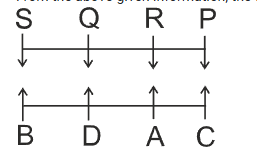
So, R sits opposite to A. Hence, the first option is correct.
2. Direction: In a row of 63 cars, black car is 32nd from the right end. What is its position from left end?
32
31
33
34
Solution:
Given:
Total number of cars = 63
Position of the black car from the right end = 32
Therefore, the position of the black car from the left end
= (63 – 32) + 1
= 31 + 1
= 32
Hence, the first option is correct.
3. Analyze the statements given below are answer the questions that follows:
Statement – I: One of the major causes of the industry's larger capacity is the argument that large facilities facilitate greater economies of scale. However, the major concern for building a large capacity is that funds will be tied up or there will be a scarcity of funds.
Statement – II: A viable alternative to larger capacity production facilities is to develop subcontractor and supplier networks.
Both statements I & II are correct.
Both statements I & II are false.
Statement I is correct, and II is false.
Statement II is correct, and I is false.
Solution:
Explanation:
Statement I: This is correct. Large production facilities do indeed benefit from economies of scale, where the cost per unit decreases as the volume of production increases. However, the concern with large facilities is that they require significant capital investment, tying up funds, and may lead to a scarcity of funds for other opportunities.
Statement II: This is also correct. An alternative to building large-capacity production facilities is to develop networks with subcontractors and suppliers, which can provide flexibility and reduce the need for heavy investment in large infrastructure.
Hence, option 1 is the correct answer.
4. Directions: In a certain code language, CROSS is written as 66, and CHART is written as 90. How will SYMBOL be written in that language?
82
93
76
88
Solution:
Given:
CROSS is written as 66 and CHART is written as 90.
Add the reverse position value of the letters of the word CROSS, then add the total number of letters in the word, to obtain the required code –
C→24; R→9; O→12; S→8; S→8
Now, add the reverse position value of the word CROSS, then add the total number of letters in the word –
24 + 9 + 12 + 8 + 8 = 61 + 5 = 66
Thus, CROSS is coded as 66.
And, CHART is written as 90.
C→24; H→19; A→26; R→9; T→7
Now, add the reverse position value of the word CHART, then add the total number of letters in the word –
24 + 19 + 26 + 9 + 7 = 85 + 5 = 90
Thus, CHART is coded as 90.
Similarly, follow the same pattern for SYMBOL –
S→8; Y→2; M→14; B→25; O→12; L→15
Now, add the reverse position value of the word SYMBOL, then add the total number of letters in the word –
8 + 2 + 14 + 25 + 12 + 15 = 76 + 6 = 82
Thus, SYMBOL is coded as 82. Hence, the first option is correct.
5. Directions: Select the number from among the given options that can replace the question mark (?) in the following series.
48, 75, 108, ?, 192
153
147
112
126
Solution:
Given:
48, 75, 108, ?, 192
Here, the pattern followed is as follows –
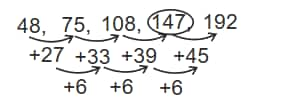
So, 147 is the missing term in the series. Hence, the second option is correct.
6. Directions: A # B means A is the brother of B;
A @ B means A is the daughter of B;
A & B means A is the husband of B;
A % B means A is the wife of B.
If W % D # G @ B & M @ I, then how is D related to M?
Father’s father
Father
Grandson
Son
Solution:
Given:
A # B ⇒ A is the brother of B
A @ B ⇒ A is the daughter of B
A & B ⇒ A is the husband of B
A % B ⇒ A is the wife of B
As per the given information, the family tree will be as follows –
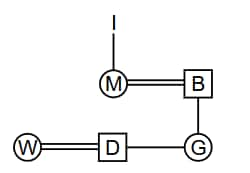
Here, the quadrilateral represents the male, and the circular figure represents the female in the figure.
So, D is the son of M. Hence, the fourth option is correct.
7. Directions: In this question, two statements I and II have been given. These statements may be independent causes or effects of independent causes or a common cause. One of the statements may be the effect of the other statement. Read both statements and select the correct answer.
I. This year College X reduced the cut-off marks to 50 from 60 for the entrance exam.
II. In the last two years, the Students Union in College X has been actively negotiating with the college administration regarding the Quality of food and Health and Hygiene standards at the College Canteen.
II is the cause and I is its possible effect
I is the cause and II is its possible effect
Both I and II are effects of independent causes
Both I and II are independent causes
Solution:
Given:
Statements:
I. This year College X reduced the cut-off marks to 50 from 60 for the entrance exam.
II. In the last two years, the Students Union in College X has been actively negotiating with the college administration regarding the Quality of food and Health and Hygiene standards at the College Canteen.
From the above-given statements, it is clear that there is no relation between the reduction in the cut-off marks and the negotiation being done with the college administration regarding the Quality of food and Health and Hygiene standards at the College Canteen.
So, both I and II are effects of independent causes. Hence, the third option is correct.
8. Directions: If ÷ means −, − means ×, × means +, + means ÷, what will come in place of the question mark (?)?
77 ÷ 7 × 17 – 49 + 7 = ?
189
119
145
169
Solution:
Given:
÷ means −, − means ×, × means +, + means ÷
77 ÷ 7 × 17 – 49 + 7 = ?
After interchanging the given mathematical signs, we get –
⇒ 77 − 7 + 17 × 49 ÷ 7
⇒ 77 − 7 + 17 × 7
⇒ 77 − 7 + 119
⇒ 189
So, 189 is the answer to the given equation. Hence, the first option is correct.
9. Directions: Select the correct mirror image of the given combination when the mirror is placed at PQ as shown below.
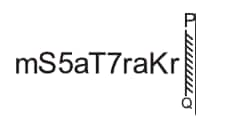




Solution:
As per the mirror image properties, closer things appear closer to the mirror in the reflection.
Here, according to the information provided, the mirror is placed on the right side of the figure (on line PQ). So, the left side of the reflected image will appear as the right side, and the right side will appear as the left side. However, the top and bottom of the reflected image will remain the same.
Thus, the correct mirror image of the given figure will be –

Hence, the second option is correct.
10. Directions: Three statements are given followed by four conclusions. Assuming the statements to be true, even if they seem to be at variance with commonly known facts, decide which of the conclusions logically does NOT follow(s) from the statements.
Statements:
I. All P is G.
II. Some G is B.
III. All B is C.
Conclusions:
I. All P being C is a possibility.
II. Some P is B.
III. Some C is G.
IV. Some G is P.
Only III does not follow
Only IV does not follow
Only II does not follow
Only I does not follow
Solution:
The possible Venn diagram according to the given statements is as follows –
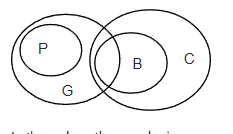
Let's analyse the conclusions –
Conclusion I: All P being C is a possibility – It is a possibility that the circle representing P is completely overlapped by the circle representing C. Thus, this conclusion follows.
Conclusion II: Some P is B – From the Venn diagram, it is evident that there is no direct relation between P and B. So, no definite relation can be drawn. Thus, this conclusion does not follow.
Conclusion III: Some C is G – From the Venn diagram, it is evident that the circles representing C and G overlap and have some parts of their area in common. So, from this, it can be concluded that some C is G. Thus, this conclusion follows.
Conclusion IV: Some G is P – From the Venn diagram, it is evident that some parts of the circle representing G lie inside the circle representing P while some lie outside. So, from this, it can be concluded that some G is P. Thus, this conclusion follows.
So, only conclusion II does not follow. Hence, the third option is correct.
Understand the different types of reasoning questions.
Practice puzzles, seating arrangements, and syllogisms regularly.
Identify patterns and relationships in problems.
Improve speed by solving timed practice sets.
Focus on accuracy to avoid mistakes.
Analyze previous years' questions to understand trends.
Develop a step-by-step approach to solving problems.
Stay patient and think logically while answering.
15 questions are asked in the CUET PG MBA examination under the Data Interpretation section. The candidates should ensure that they score the maximum possible marks under this section to ensure a good MBA score. The major topics under this section are:
Data Interpretation | Pie Charts, Line Charts, Bar Graphs, Tabular Charts, Mixed Graphs, Data Sufficiency, Graph Number Systems, Tabulation, Sets and Venn Diagrams |
Here are a few CUET PG MBA last minute revision questions of Data Interpretation.
1. Direction: Analyse the graph/s given below and answer the question that follows.
Study the following bar graph giving Economic Indices for the period 1961-62 to 2001-02 to answer the question.
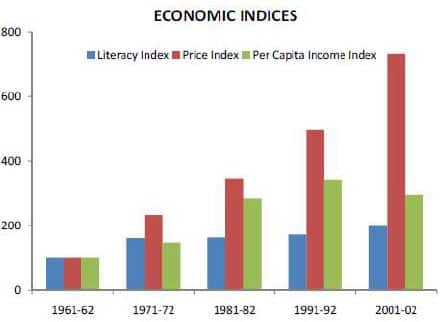
What are the respective indices of literacy, price and per capita income for 2001-02, taking 1971-72 as the base period?
124.1, 313.8, 200
313.8, 124, 201
313.8, 124.1, 190
124.1, 313.8, 194
Correct Answer:- A
Explanation:-
Literacy index for the 2001-02 with 1971-72 as the base period: 200 / 161.1 × 100 = 124.1
Price index for the year 2001-02 with 1971-72 as the base period: 732 / 233.3 × 100 = 313.8
Per capita income index for the year 2001-02 with 1971-72 as the base period: 296 / 148.2 × 100 = 200
Hence, the answer is the 1st option.
2. In which period the per capita income index increases at a faster rate than the price index as compared to the preceding period?
1971-72
2001-02
1981-82
1991-92
Correct Answer:- C
Explanation:-
Year | Per Capita Income Index | Price Index |
71-72 | 48.20% | 133.30% |
01-02 | There is a decrease, so no need to check | |
81-82 | 234.8 - 148.2 = 92.2% | 344.9 - 233.3 = 47.8% |
91-92 | 31.41 - 28.45 = 19.8% | 406.2 - 344.9 = 43.5% |
So the increase is fastest in 1981-82 over the previous year.
2. DIRECTIONS : The question below is followed by two statements marked I and II. Mark as your answer.
What is the difference between the shares of profits of Rekha and Nutan out of a profit of Rs.
6,000 at the end of the year?
I. Rekha invested Rs. 50, 000 and withdrew Rs. 1000 after 4 months.
II. For the last 8 months, Nutan’s capital was 125% of Rekha’s.
If the data in statement I alone are sufficient to answer the question, while the data in statement II alone are not sufficient to answer the question.
If the data in statement II alone are sufficient to answer the question, while the data in statement I alone are not sufficient to answer the question.
If the data in statement I alone or in statement II alone are sufficient to answer the question.
If the data from both statements I and II together are not sufficient to answer the question.
Correct Answer:- D
Explanation:-
Statement I gives the investment of Rekha only, so it is not sufficient. Statement II does not give the complete information regarding the amount invested by Nutan, so it is not sufficient. Even by combining, we do not know anything clearly about Nutan’s investment for the whole year. Hence 4th option.
4. DIRECTIONS: The question below is followed by two statements marked I and II. Mark as your answer.
What is the cost of laying the carpet in a rectangular hall?
I. Cost of the carpet is Rs. 450 per square metre.
II. The perimeter of the hall is 50 meters.
If the data in statement I alone are sufficient to answer the question, while the data in statement II alone are not sufficient to answer the question.
If the data in statement II alone are sufficient to answer the question, while the data in statement I alone are not sufficient to answer the question.
If the data in statement I alone or in statement II alone are sufficient to answer the question.
If the data from both statements I and II together are not sufficient to answer the question.
Correct Answer:- D
Explanation:-
Statement I gives the cost of the carpet only, and no dimensions are known, so is not sufficient alone. Statement II gives us the perimeter of the hall, but since the hall is a rectangle, we still do not know the length and breadth of the room. So not sufficient. Even when combining, we do not know the dimensions of the room. Hence option (4).
5. Directions: Select the Venn diagram that best illustrates the relationship between the following classes.
Men, Engineers and Fathers
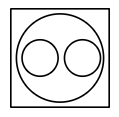
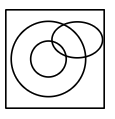
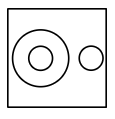
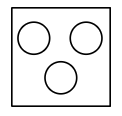
Solution:
Given:
Men, Engineers and Fathers
.Based on the general information, all the fathers are men. So, the circle that represents the father will lie inside the circle that represents men. Also, some fathers can be engineers, but not all fathers need to be engineers, and not all engineers need to be fathers. Similarly, some engineers can be men and some can be women also. So, the circle that represents engineers will be overlapped by both the circles of men and fathers.
So, the Venn diagram is as follows –
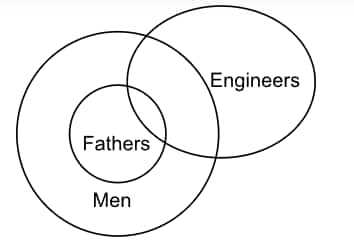
Hence, the second option is correct.
Data Interpretation (DI) is an important part of the CUET PG MBA exam and tests your ability to analyse data quickly and accurately. This section focuses on tables, graphs, and charts, where clear thinking matters more than complex calculations. With the right approach and regular practice, you can improve speed, accuracy, and confidence in solving DI questions.
Focus on tables, bar graphs, pie charts, line graphs, and mixed data sets. Knowing these formats helps you read data faster during the exam.
Revise percentages, ratios, averages, and approximations. Strong basics reduce calculation time and help avoid mistakes.
Use approximation whenever possible instead of exact calculations. This saves time and works well for multiple-choice questions.
Practise scanning data carefully to avoid misreading values. Accurate reading is as important as solving the question.
Solve CUET PG MBA and similar exam DI questions to understand difficulty level and improve accuracy under time pressure.
Candidates can use the practice resources from Careers360 to improve their preparation for the CUET PG MBA 2026 exam.
Title | Download Link |
CUET PG MBA 2026 Vocabulary List | |
CUET PG MBA 2026 : Quantitative Aptitude/ Maths Questions with Solutions | |
CUET PG MBA 2026 : Data Interpretation Questions with Solutions |
Frequently Asked Questions (FAQs)
The CUET PG MBA 2026 exam contains a total of 75 questions. These questions are distributed across various sections, including English, Logical Reasoning, Quantitative Ability, and Data Interpretation, which together assess a range of skills required for the MBA program.
To pass the CUET PG MBA 2026 exam, candidates must secure at least 45% of the total marks.
The exam follows a marking scheme where each correct answer earns the candidate 4 marks. However, negative marking is implemented for incorrect answers, with a deduction of 1 mark for each wrong answer. This encourages candidates to attempt only those questions they are confident about, minimizing guesswork.
The CUET PG MBA 2026 exam is divided into four major sections:
English/Comprehension: This section tests your proficiency in English language skills, including grammar, vocabulary, and reading comprehension.
Mathematics/Quantitative Ability: This section evaluates your ability to solve quantitative problems, covering topics such as percentages, time and work, and algebra.
Logical Reasoning: This section assesses your reasoning and analytical skills through problems involving puzzles, series, analogies, and more.
Data Interpretation: This section requires you to interpret and analyze data presented in the form of tables, graphs, and charts, testing your ability to draw conclusions and make decisions based on data.
Last-minute revision questions help you quickly revise important topics without going through full books again. They refresh key concepts, improve speed, and help you stay confident just before the exam.
Among top 100 Universities Globally in the Times Higher Education (THE) Interdisciplinary Science Rankings 2026
Partnerships with diverse assortment of global organizations and industry leaders | Industry-driven curriculum
B.Sc (Hons) Admissions 2026 Now Open | Ranked Among the Top 100 Universities in the World by QS World University Rankings 2025
BBA | BBA (Hons.) | BBA+ MBA (Integrated) | AACSB, Business Graduates Association, AMDISA Member | Merit-Based Scholarships | Application Deadline: 20th Jan'26
#36 in NIRF, NAAC ‘A’ Grade | 100% Placement, up to 30% meritorious scholarships
Recognized as Category-1 Deemed to be University by UGC | 41,000 + Alumni Imprints Globally | Students from over 20+ countries